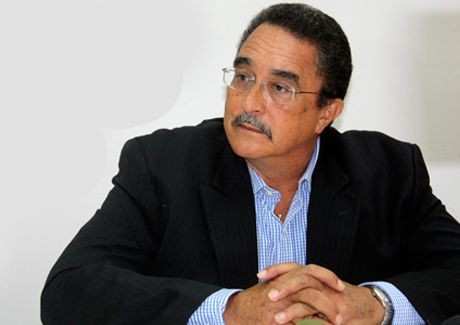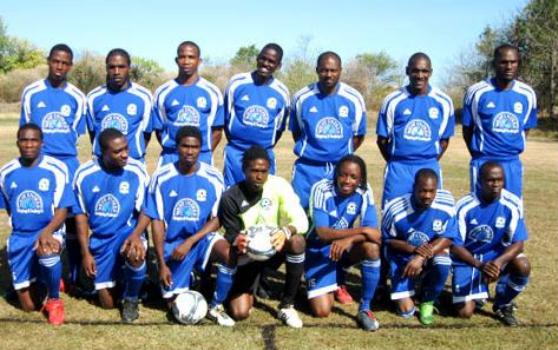
The former prime minister, Allen Chastanet, poignantly argued in the House of Parliament that there is no one else to blame for Vieux Fort’s socioeconomic malaise than Dr. Kenny Anthony.
In 1997 was when you (Dr. Anthony) should have put the cruise ship port in Vieux Fort. That would have been the cheapest way to produce the greatest economic impact in Vieux Fort overnight. So when you want to come here and pontificate on history… and interpret numbers the way you want to…you were the prime minister, the minister of finance for fifteen years. All the projects you talking about, why didn’t you get them done, why don’t they have a cultural center if you think it was so important? Why it took you so long to put an administrative center in there? And you know why the administrative center didn’t go up. Because there was no planning approval, the land had not even been transferred to NIC; and also you going to spent $70 million dollars, which is going to be over $2 million dollars in interest per year. And you not even renting space in the South for $2 million. It makes no sense. Absolutely no sense Mr. Speaker. If the member (Kenny Anthony) was genuinely concerned about the people in the South, he would have done that work long ago. There is no excuse, you had fifteen years…In fact you had ten years you didn’t do it, you had five years to think about it, you came back for another five years and you still didn’t do it. You can’t hold anyone else responsible for that. There is one person responsible, YOU, nobody else, just you, so don’t run away from that.
Vieux Fort’s very own philosopher, Nicholas Moffat, and Alexander Clarke, a Vieux Fort business innovator, would agree with Allen Chastanet. They will unbashfully and forcefully impress upon you that Dr. Kenny Anthony bears the lion’s share of the blame for Vieux Fort’s current predicament.
Born and raised in the section of Vieux Fort called the Mangue, adjacent to Bruceville and home to one of the three main Vieux Fort gangs, Nicholas Moffat said that he used to be a big-time Kenny Anthony supporter back in the early days of his reign. But now it seems Moffat has become the former prime minister’s biggest critic. Why, what’s his beef against Kenny Anthony?
He laments that Kenny Anthony has let Vieux Fort down, he has provided no leadership, he is not a leader by any stretch of the imagination, for in his twenty-five years as Vieux Fort’s district rep he is yet to present a coherent vision for Vieux Fort. To Moffat, Dr. Anthony is a man with no vision. And according to the philosopher (and the Bible), where there is no vision, the people perish. If so, no one should be surprised by the recent spate of violence; the people are indeed literally perishing through self-destruction.
Like Lot pleading with the Angels that came to rain destruction on Sodom and Gomorrah, I countered this criticism with something akin to: “but under Kenny Anthony, we got the fishery complex, the National Skills Development Center (NSDC), a free zone complex, a Bruceville promenade, footpaths, a renovated public square, an IT center, residential developments at Contonement, etc., etc.”
The philosopher said that these are just physical constructions, they don’t constitute a vision.
So I said that Dr. Anthony had articulated a vision of rejuvenating downtown Vieux Fort, and a vision of transforming Vieux Fort into a university town, of which Spartan Medical University and the American International Medical University are fruits. And I think the district rep also had a vision of a health and wellness center that would foster medical tourism.
At this point, the philosopher was running out of patience. He asked, “Where is the medical tourism or any kind of tourism for that matter?” And he said that downtown Vieux Fort is anything but rejuvenated, and again these are activities, not a coherent, integrated vision for the district.
Moffat is so vehemently opposed to Kenny Anthony, that the once stalwart SLP supporter has switched his allegiance to the UWP, and, to him, Kenny Anthony can do no right.

Alexander Clarke, on the other hand, isn’t even against Kenny Anthony and the SLP; in fact, I suspect he is leaning more towards SLP than UWP. But his criticism of the district rep is more damming than that of Moffat because his is more evidenced-based. Following is a summary of Clarke’s take on the reign of Kenny Anthony.
The Roots Alley Story
According to Clarke, in 1985, he and other residents of Westall Group B, later renamed Roots Alley Lane, an area that formed part of what was historically called the Mangue, established an organization called Roots Alley to look after the Vieux Fort community. As such, Roots Alley began by conducting cleanup and beautification campaigns. Over the years, Roots Alley gave Vieux Fort public facilities facelifts with fencing, painting, and the planting of flowers. It donated books to the library, refurbished the St. Jude preschool and donated furniture to the school, sponsored medical treatment and surgery for members of the community, provided meals to the elderly, and helped rebuild their homes. In addition, the organization staged such cultural and sporting activities as Vieux Fort Day, theatrical plays, queen shows, and sports tournaments, and went as far as Trinidad and Jamaica to help strengthen youth organizations.
Early on, given a membership of about 300 mostly teenagers with an interest in sports, the organization formed a football team called Roots Alley Rockers later renamed Roots Alley Ballers. Soon the football club was followed by basketball, volleyball, table tennis, and track and field teams. To finance its operations, Roots Alley partnered with the business community and conducted such fund-raising activities as raffles, dances, and blocko’s. And to help manage and coordinate its sporting and community development activities, it established an office staffed with full-time employees, including field officers and an administrative assistant.
Roots Alley, an organization arising from what some would call a ghetto, in a town whose residents many discard as lazy and unambitious, and founded and led by grassroots members of the said community, mostly teenagers, became the stuff legends are made of.
To begin with, the organization produced athletes for the national team of all the sports in which it was engaged—football, cricket, track and field, table tennis, and volleyball. One of its track athletes, Bernard Fox Henry, has the honor of winning St. Lucia’s first Carifta Games gold medal when he won the 1500 meters gold medal in 1988. And its basketball player, Anthony (Bock) Joseph won the 2006 national basketball player of the Year. However, football is where Roots Alley has left its greatest mark. Roots Alley Ballers won over 15 national football tournaments, and won national football club of the year three times in a row (1995-1997). It has produced over 30 national footballers, three of whom have won national footballer of the year, and several have plied their trade in Trinidad’s professional football league, including Titus “TT” Alva, who for several years was the leading goal scorer in that league. At one time, Roots Alley Ballers had as many as nine footballers on the national team, and as winner of the 2004 national football club tournament, the club represented St. Lucia in that year’s Concacaf football tournament held in Trinidad. With such exploits and heroics, Roots Alley took its place alongside CYO, VSADC, and Dames as one of the greatest sports clubs in the history of St. Lucia.
But not everyone was enamored with the organization. When Roots Alley won the national club award in 1995, the authorities refused to give the club the requisite trophy because they labeled Roots Alley a ghetto club dealing in drugs. So the club would have to wait for two years and the ushering of SLP into power in 1997 to receive official and due recognition for its accomplishment. And to this day Roots Alley hasn’t received its prize money for winning the 2004 SLFA national football club tournament. Yet when the club represented St. Lucia in that year’s Concacaf football tournament, it had to cover all expenses from its own pocket.

But the Roots Alley story, especially for the benefit of those who insist Vieux Fortians are lazy and lacking ambition, doesn’t stop there. Recognizing that many of their members were unemployed, and paying heed to the proverb charity begins at home, the organization undertook to create and seek employment for its members. With the help of the Caribbean Network for Integrated Rural Development (CNIRD), it held horse husbandry training programs to facilitate its members in providing horseback riding as a tourist attraction; it helped members to establish fish ponds as a commercial venture on land leased from the government, and it served as a job placement agency, finding work for its members, particularly in the construction industry.
Around 2001, the government sought to modernize and regularize the garbage disposal system in the Vieux Fort area and was planning through the bidding process to select a private entity that would provide the service. Roots Alley saw this turn of events as a golden opportunity to uplift its operations to a higher plain and to secure a source of employment for its members.
The organization left nothing to chance. It secured the help of the National Research and Development Foundation (NRDF) to prepare the bid proposal. With the help of the Centers for Natural Resources and Development (CNRD), it sent members to Trinidad for training and exposure in the art and science of sanitation and garbage collection and disposal. A partner organization in Martinique promised to donate garbage bags and bins for all households in the Vieux Fort area. It had already secured finance from St. Lucia Development Bank (SLDB) to purchase the required garbage trucks and was in the process of conducting fundraisers to amass matching funds.
The organization had every reason to be confident it would win the bid. For years it had been involved, albeit for free, in Vieux Fort garbage collection and beautification projects, so it had a leg up on the competition. It was the same SLP government presiding over the bid that no sooner had it held the reins of power had staged a lavish official ceremony at Coconut Bay Resort to bestow on the club the award of national club of the year that it had been denied for two years, and as additional honor had renamed Westall Group B to Roots Alley Lane. And, before that, it was on the horses of Roots Alley members that, like Christ’s triumphal entry into Jerusalem, the prime minister had ridden to his inaugural launch as the district rep candidate for Vieux Fort South.
So you could well imagine Roots Alley’s disappointment when the garbage disposal contract went to Sadoo of Micoud, and not to the club. According to Alexander Clarke, it took the wind right out of their sails. It dissipated their will and drive. Here they were having started with nothing and through share drive, hard work, and perseverance had vanquished the St. Lucia world of sports, and just when they thought they would take things to the next level and create gainful employment for themselves and a sustainable source of finance, it was taken away from them. So close yet so far. They had followed all the rules, done all the right things, became conscientious corporate citizens, yet it wasn’t enough. They had been punished for good behavior. With their spirits broken, Roots Alley as an organization was never the same again.
Listening to Clarke relate this story, I thought of Eugene in The Stall Keeper. Paying witness to a fire reducing Eugene’s store to ashes, the people of Vieux Fort said,
Pòdjab Eugene, pòdjab,” ‘as if to say it was no use trying, because even when one tried, when one scratched and fought, when one gave it one’s all, and when it appeared that one was going to make it, someone or a force beyond one’s control would just come and snatch it all away… So why even try?
Besides the collection and garbage disposal affair, following is another example Clarke provided of how Dr. Kenny Anthony’s approach to development and project implementation undermined the social and community fabric of Vieux Fort and contributed to the demise of Vieux Fort sports clubs.
Vieux Fort is mostly below sea level, hence the reason the areas of Bruceville, the Mangue, Roots Alley, and the Bacadere were swamp lands. This meant that anytime rain falls these areas become soggy, forcing residents to tread in mud to get home. So one of the first initiatives the Kenny Anthony SLP administration implemented when it got into power in 1997 was to build a series of concrete footpaths throughout these areas and in other parts of the country. These footpaths were in some ways an acceptance of defeat, and legitimatizing unplanned, illegal development, but to the residents of these communities, the footpaths were a welcome relief. So Alexander Clarke had no quarrel with the footpaths, but rather with how the project was implemented.
According to Clarke, instead of giving the sports clubs (the socioeconomic structure holding the community together) the contracts to build the footpaths, who in turn would employ their members, thus strengthening the sports clubs, enhancing their viability, sustainability, and relevance, and leaving them in better positions to take care of their members even after the contracts have ended, the contracts were given to individual party supporters, who in turn may well have hired members of the sports clubs. But these individual contractors had little interest in sports and community development per se, and the completion of their contracts meant the end of their story as far as involvement in community development. However, this method of project implementation meant a lost opportunity to give decisive support to the sports clubs, and, according to Clarke, represented yet another way in which the implementation of projects undermined the sanctity and integrity of the sports clubs.

Now it may well have been the case that Sadoo’s bid would have done greater justice to garbage disposal in Vieux Fort than the Roots Alley proposal. And it may also have been the case that Sadoo helped finance the campaign of the Labour Party. We can’t be too naïve; we have to face the realities of our political process. The political parties need proactive loyal supporters, hacks even, and the finances of deep-pocket businesses to win elections. But these come at a cost. When the party gets in power, it has no choice but to find ways to reward such supporters and campaign financiers, or else how will it get these people/entities onboard to win the subsequent election? So according to the philosopher, Nicholas Moffat, it didn’t have to be an all-or-nothing situation. The government could have given Roots Alley the garbage disposal contract for Vieux Fort town, while leaving the suburbs and other outlying areas for Sadoo. And in the case of the footpaths, at least some of the contracts could have been reserved for the sports clubs.
Both Moffat and Clarke voiced another way in which the advent of the prime minister and Vieux Fort South district rep undermined the sports clubs. They said the district rep introduced the prime minister cup tournaments, which somewhat displaced the Vieux Fort sports leagues. Before that, the sports clubs had healthy and direct relationships with the business sector, and each sports club had its own corporate sponsors. But with the advent of the Prime Minister’s Cup, corporate funding was channeled to one source, the prime minister tournament, and in the process the sports clubs became distant from the business sector and the link with them become tenuous at best.
So once, through alleged mishandling of the sponsorship monies given to the prime minister representatives, the business sector lost confidence that their funding was being put to its intended purpose, sports sponsorship as a whole suffered and was blighted.
According to Clarke and Moffat, the Prime Minister’s Cup hurt Vieux Fort sports in another way. The branding of the prime ministership with sports, politicize sports in Vieux Fort, with the consequence that athletes and sports organizers who wanted nothing to do with Kenny Anthony moved completely away from sports and one can well imagine businesses opposed to the prime minister and SLP withdrawing their support.
What these scenarios seem to suggest is that Kenny Anthony’s modus operandi of administering to his district may have ingratiated himself in Vieux Fort in a manner that created captive voters, but which was inimical to the district’s socioeconomic development.
In summary, according to Clarke, so ill-advised has been government intervention in Vieux Fort, that sometimes the town would have been better off without them, even when motivated by good intentions. For example, Dr. Kenny Anthony has received much praise for his social programs and for helping to foster a kinder and gentler Vieux Fort and St. Lucia. However, Clarke said that in 1997, at the cusp of Dr. Anthony becoming prime minister and the Vieux Fort South district rep, Vieux Fort had a healthy social and community infrastructure led by a host of proactive sports organizations, engaged and integrated into their communities. These included Square United, Roots Alley, Wadad Posse, Ghetto Lions, and Green Lake. The sports clubs competed in a lively Vieux Fort league structure and encompassed both men’s and women’s teams, teams of various age groups, and the full range of popular St. Lucian sports, including cricket, football, basket, volleyball, and table tennis.
Now, twenty-five years, later, thanks in part to the district reps’ approach to development and public project implementation, the sports organizations and the social and community infrastructure they helped span and maintained are largely none existent, and Vieux Fort’s perceived dependency syndrome has deepened. Sports in Vieux Fort have been reduced to a few football teams competing in national tournaments. In other words, Vieux Fort’s social fabric has regressed under Kenny Anthony. Instead of the sports organizations continuing their proactiveness in raising funds and looking after their community, they switched to depending on the district rep for jobs and patronage. It was as if since under UWP the sports clubs didn’t expect much help from government, they were forced into independence and proactiveness; whereas the reverse occurred with the advent of Kenny Anthony.
Now, in fairness to Dr. Anthony, even if one agrees with Moffat and Clarke that the district rep’s approach to implementing projects in Vieux Fort has contributed to the decline of sports organizations, there could be other reasons that help explain the phenomenon. For example, the Great Recession of 2008 to 2009, considered the worst economic downturn in the U.S. since the Great Depression, caused economic hardship in St. Lucia, which would have affected the sports clubs and the flow of corporate sponsorship. So too would the decline of Port Vieux Fort operations, which provided high waged, largely unskilled employment to Vieux Fortians. The establishment of Blackheart and FIFA national tournaments would have reduced the relevance of local football leagues and would have encouraged the concentration of football activity into a smaller number of stronger teams, giving each team a better chance of winning the tournament.
Also, the growth of drug operations and criminal gangs would have given youths an alternative form of employment and socialization. But, of course, this brings into play the question of the chicken and the egg, which comes first, because the demise of the sports organizations would have made available to the gangs a larger pool of recruits, thus largening the gangs and giving them greater prominence in Vieux Fort society.
Off course all wasn’t lost. Though a shadow of what it used to be, Roots Alley remains a force in St. Lucian football. Some of the founders and leaders of the organization are now school principals, government officials, business innovators, and owners and operators of design, construction, and landscaping enterprises.
The Central Government?
However, Alexander Clarke isn’t through with his criticism of Kenny Anthony in particular and successive administrations in general. In brief, he speaks of government neglect and misadventure. He said that some view the ongoing expansion and buildup of Vieux Fort as progress and development but nothing can be further from the truth. He said that in actuality Vieux Fort has regressed since the time of the Americans. The Americans he said, bequeathed Vieux Fort with unparalleled road infrastructure, state-of-the-art drainage, sewerage, potable water, and electric power systems. They also left Vieux Fort with two underground tunnels that now could have served as tourist attractions.
In their neglect of Vieux Fort, the central government failed to maintain and improve these systems. The flooding and resultant road and beach damage that obtained in the aftermath of the 2010 Trough was a consequence of failure to maintain the American drainage system. Bridge Street at the Bacadere side of town and its accompanying bridge that used to provide a second entry (outlet) into Vieux Fort has disappeared. Bwa Shadon which used to serve as one of the most popular family outing sites in the South has become a danger, stay-away zone.
Indeed, rather than maintaining and improving on the infrastructure that the Americans bequeathed Vieux Fort, apart from those that served the nation as a whole such as the airport and seaport, the government was more interested in carting away to Castries some of what the Americans left behind, that is, what lend themselves to dismantling and transporting, including several buildings.
According to Clarke, there was a time Vieux Fort was the envy of St. Lucia. Its sports rivaled that of Castries. Its popular music bands were among the best on island. It had its own carnival and its own calypso competition. Indeed, its carnival and queen show were held in higher regard than the national ones held in Castries (See Marcus Andrews writeup for a sense of Vieux Fort’s past glory).
Clarke argues that the recent “so-called developments” that have taken place in Vieux Fort are largely ill-conceived, unsustainable, poorly utilized, and sometimes an unfortunate waste of public funds. The fishery complex is ill-conceived because its location at the mouth of the town precludes the logical location for a cruise ship port that would allow passengers to disembark and stroll down the middle of town. Also, others have argued that the topography of the bay provides natural protection to sea-going vessels so the elaborate barrier of the complex was not necessary. The free zone next to the airport is largely a white elephant, serving more as a glorified storage facility than a bonafide free zone. The George Odlum National Stadium, a gift from the Chinese government, notwithstanding its use as a hospital, has become a health hazard. Several years ago, the government spent millions of dollars building infrastructure at La Tourney to accommodate a commercial district, only for the project to be aborted since it was under the direct flight path of incoming planes. Yet a Vieux Fort air traffic controller had duly won the government that in terms of air traffic international standards, the development was ill-advised. Most of these initiatives were imposed on Vieux Fort without much of any consultation with Vieux Fortians and in some cases against their advice, yet when things don’t work out the government and others place the blame on Vieux Fortians.
Another aspect of the ill conception of some of the developments is the failure to recognize and appreciate that because of our small population, single-purpose facilities are likely to be underutilized. Thus, rather than the fishery complex serving strictly as a fish depot, consideration could have been given to it also serving as a produce market, a tourist attraction (maybe even equipped with an aquarium), and a venue for entertainment and cultural events.
The recently built ICT center on Commercial Street is woefully underutilized because it is distant from student traffic and was made redundant even before its completion by the ubiquitousness of cell phones, tablets, computers, and WIFI. But if the center was also serving as an ICT training center with regular courses on offer, and if it was collocated with the library, and if also all of that was incorporated into the administrative center whose construction was aborted, then the problem of limited utilization would likely disappear.
Inadequate management and maintenance is yet another associated blunder, for nature abhors vacuums. If activities and structures are not properly managed and maintained then disarray, everything goes, and deterioration sets in. This suggests that if there isn’t a will and a plan to manage and maintain such enterprises then they should not be undertaken in the first place. The Fishery complex is unkept, unhygienic, unseeming, its outlying areas serving as toilet.
Who to blame? The curse of Vieux Fort? However, inquire of any business how their offices, buildings, and grounds are well kept and their employees do what they are supposed to do where, when, and how, they will not hesitate to tell you that they have paid staff or contractors that do the maintenance and cleaning, and they have a management and incentive system in place that ensures, or insist that things be done a certain way.
Without similar systems in place at the fishery complex, why should we expect to match the results or performances of these businesses? Millions of government (or rather Japanese) dollars were spent building the largest fishery complex in the Eastern Caribbean, yet fish sellers insist on selling fish on Vieux Fort streets. Likewise, produce vendors ignore the produce market facility prepared for their use, and insist on setting their produce stalls or mats along Clarke Street. Are Vieux Fortians also to blame for that? Well, most of the produce vendors are not from Vieux Fort South. Isn’t that a question of management and administration? Can’t the authorities impose discipline on fish and produce vendors in much the same way they had imposed COVID-19 protocols and restrictions?
It’s invariably a matter of will and desire.
Indeed, Clarke provides a litany of failed and or ill-advised government projects in Vieux Fort that, even if you don’t place much stock in obeah and conspiracy theories, will leave you with no choice but to entertain the notion that Vieux Fort is truly cursed. The recently built police station with individual offices the size of penthouses in luxury hotels has been evacuated because of mold infestation. The Freezone, as mentioned above, never fulfilled its mission. The recently built National Skills Development Center (NSDC) is closed and in disrepair. The Technical Vocational Secondary School catering to less academically inclined students was discontinued. As mentioned above the fishery complex is deteriorating, unkempt, in disrepair and not serving its intended higher purpose of fish processing and fostering expanded markets. The recently established ICT center is largely a white elephant, its computers and other equipment are in disrepair and of little use. The Vent, a wooden structure on upper New Dock Road, that used to serve as an entertainment venue or hub, is no longer in use. The Vieux Fort Library is no more because of dilapidation and mold infestation. All thanks to the promise of DSH, the garbage dump was condemned so now Vieux Fort’s refuse is transported all the way to Castries, the abattoir, a $14 million gift from the Taiwanese government, which has never been used, is wasting away and is under the assault of thieves, and the Beausejour Farm that once upon a time used to provide the South with daily supplies of fresh milk, and where many an agricultural student learned the practical rudiments of animal husbandry was abandoned. The basketball court is in disrepair and with no lights. All public laundries are no longer in operation. The Vieux Fort Square is mostly on lockdown. Vieux Fort sporting activities have been reduced to just a few football teams. Not only is the EC$55 million Chinese gift of a National Stadium not serving its intended purpose but has become a health hazard. There is no organized lawn tennis, table tennis, basketball, cricket, volleyball, and track and field except what exists at the schools. No Vieux Fort football leagues, no sports clubs, only teams that participate in national football tournaments. There are no cultural, sports, and entrepreneurial programs, no social, human development plans and programs, no theatre groups, no dance groups. No youth camps, employment, or training programs for students during their summer vacation. Even Imani Models, a mainstay of Vieux Fort’s cultural scene that had been in operation for over twenty-five years, Winner of the 2018 Jako Prize, have gone silent.
If this is a fair snapshot of the Vieux Fort socioeconomic landscape, then it means there is nothing in place to occupy the young people. There are no safe, wholesome places for them to congregate and socialize. Apart from the Vieux Fort primary school, there is not even a public space to hold meetings and conferences. The youths are faced with a deep, wide void. In this kind of social and cultural desert, how do we expect the youths to flourish? One would have to agree with Alexander Clarke and Nicholas Moffat that over the twenty-five years that encompasses Dr. Anthony’s political reign, there has been a marked decline in Vieux Fort’s social assets, its socioeconomic infrastructure. If so, should we be surprised by the growth of criminality in Vieux Fort? The surprise should be that there isn’t more of it.
In this desert, what else but the prickly cactus of drug gangs and theft rings can flourish?
In summary, the question Clarke poses to those who insist on blaming Vieux Fort’s unfulfilled promise on the laziness and ambitionless of its people is this: How can that be when it is the central government that decides what to take away and what to give; when, how, and where to establish facilities and developments with little input from Vieux Fortians; when they are the ones in charge of the management and maintenance of public infrastructures and programs; when they are the ones that come closest to running Vieux Fort?
Clark and Moffat’s angst is understandable. But is it the case of we are expecting too much from government? In a world of very limited resources that have to be shared among seventeen constituency districts, meaning there is competition among the district reps for the bacon, how much bacon can any one district rep bring home. Also, the cabinet ministers and district reps can set policy and sign off on projects and programs, but it is still the ministries and government departments that actually implement these initiatives. Meaning, the implementation, management, and maintenance of programs and facilities are not totally in the hands of cabinet ministers. Thus, other persons in the system can frustrate their efforts and initiatives.
My contention with the district rep isn’t that he didn’t do enough for Vieux Fort or St. Lucia. After all, the 2011 Kenny Anthony Labour administration orchestrated what is probably the most ambitious employment program of any administration. Despite all its hoopla, the current administration’s Youth Economy probably hasn’t delivered even half as much as Kenny Anthony’s youth-oriented initiatives.
I will fault the district rep on two counts. First his approach to administering the district, and second an insufficient emphasis on job creation and the stimulation of economic activity in Vieux Fort.
Apparently, Dr. Anthony’s approach to administering his district was to surround himself with party hacks and stalwart SLP supporters, not necessarily because they have Vieux Fort at heart nor that they have demonstrated a passion for Vieux Fort development, nor that they are leading the way in endeavors geared toward the upliftment of Vieux Fort, but for their loyalty, and willingness to toe the line. To some extent, the district rep refrained from consulting the true leaders of the community, regardless of their party stripes, those who for years have been moving mountains to uplift Vieux Fort sometimes at great personal sacrifice, and then let these persons champion his agenda, his vision for Vieux Fort.
It’s a strange thing. There are persons and entities in various communities who for years are keeping their communities alive, be it in the area of sports, culture, environmental beautification and preservation, at great sacrifice to themselves, expending their own personal resources. But when government programs/resources come along, instead of putting these programs and resources in the hands of these community paragons, who over the years have developed expertise in the activity in question, they are given to the party hacks and supporters as reward for their loyalty but who may have little expertise and genuine interest in the area of endeavor. What happens after the money runs out or the party exits power? These favored party supporters exit the stage and the task of keeping the community alive falls back on the community paragons, now weakened and demoralized. This is what Clarke was referencing when Roots Alley was passed over for the Vieux Fort garbage disposal contract and when some of the contracts to construct the footpaths were not given to the sports clubs.

My second contention is that the district rep didn’t focus sufficiently on stimulating economic activity and job creation in Vieux Fort. Above, we quoted Allen Chastanet in his chastisement of Kenny Anthony for not establishing a “cruise ship port in Vieux Fort, that would have been the cheapest way to produce the greatest economic impact in Vieux Fort overnight.” The southern business community would applaud and say Chastanet wasn’t far from the truth. Because at a 2015 Vieux Fort economic development symposium organized by STDC and attended by who is who in the South’s business community, the leaders of commerce and industry cited a marina (and by extension a cruise ship port) as the single most important activity that would stimulate economic activity in Vieux Fort.
For years Port Vieux Fort has had to make do with a crane that breaks down every so often. Port Vieux Fort stevedore supervisors have made no bones that it is because of the crane and other problematic equipment that some of the shipping lines—CMA, CGM, Tropical Shipping, and King Ocean—are no longer using Port Vieux Fort as a transshipment point, thus causing the contraction of port operations. Of course, SLASPA says no, the crane had nothing to do with the migration of the shipping lines, rather the Authority made mention of possible changes in the shipping companies’ business model, the regional competitiveness of the transshipment business, and the limited volume of cargo destined for Vieux Fort as possible explanations, and it complained of labor inefficiency and poor work ethic at the port. But whether SLASPA or the stevedores are correct, as the prime minister and minister of finance, given the central role Port Vieux Fort plays in the economy of the district, why fool around with a problematic crane, why not spend the two to three million US dollars a crane cost and resolve the issue once and for all. One stevedore said that, baffled by the fact that the crane hasn’t caused any deaths, the engineer whom the crane manufacturer sent to repair the crane, intimated that St. Lucia must have some very strong voodoo.
In his chastisement of Kenny Anthony, Chastanet also raised the issue of the administrative center that Kenny Anthony’s 2011 administration had embarked on nearing the end of the political term. Chastanet said that the $70 million initiative would have been a total waste of money because the $2 million annual interest payment on the loan would have exceeded government rental payments in Vieux Fort. I don’t wish to investigate nor debate the correctness of Chastanet’s calculations, and saving on rent isn’t the only rationale for building an administrative center. For example, consideration must also be given to the savings in time and resources to households for not having to travel to Castries to secure important documents, the reduction in Castries traffic congestion, the amenities like conference rooms the center would likely have encompassed, and the geographical equity of access the center would engender. Chastanet has lost the elections, but apparently he is yet to disabuse himself of the debunked notion that government can run like a business.
As soon as the results of the 2016 elections were announced, I knew that Chastanet would abort the construction of the administrative center. Why? Because at this point in time, if I had $70 million dollars to spend in Vieux Fort, I would not have spent it on an administrative center, I would have spent it on a definite economic stimulation activity like a marina, like a cruise ship port. I would even consider taking a page from Chastanet and using some of that money to entice call centers and other such enterprises that employ a high concentration of young people. If I had a choice. But I didn’t have a say in the matter, for I can’t tell government how to spend the people’s money, and if the center wasn’t built, Vieux Fort would never see any of that money. So being the provincial Vieux Fort patriot that I am, I was disappointed when the project was canceled.
The good book says man shall not live by bread alone, meaning man needs bread to live.
Apparently, instead of zeroing in on unemployment bursting measures and activities, the former prime minister and current Vieux Fort South district rep focused on paving sidewalks and promenades, giving the road from Clarke Street to Gablewoods Mall a facelift, renovating Independent Square, constructing footpaths, and belatedly attempting to build an administrative center. All worthy causes, all politically savvy endeavors in light of the political reality of having to reward party stalwarts and the visibility and hence political mileage of these projects. But considering the joblessness crisis that Vieux Fort faces, these projects should have taken a backseat to economic stimulation job creation activities. Meaning, a marina/cruise ship port should have been given priority over an administrative center. And the purchase of a new crane to ensure Port Vieux Fort remains alive and viable should have taken precedence over promenades, sidewalks, and road facelifts.
A Hero or a Villain, A Blessing or a Curse, A Savior or a Failure
In deference to Dr. Kenny Anthony, Prime Minister Philip J Pierre had offered the former prime minister the opportunity to serve as a senior cabinet minister in a ministry of his choosing, but Dr. Anthony declined the offer citing health and his legal workload as the reasons for his refusal. Of course, this didn’t prevent some people from speculating that the real reason behind his decision was that he was standing on principle and keeping his pledge of never sitting in a cabinet that includes Richard Frederick whom he once described as the “the most frightening prospect” of St. Lucian politics” (and of whom some are saying Philip J. Pierre made a deal with the Devil to win the elections). The same way the former prime minister had stood on principle when, as leader of the opposition, him and his other SLP district reps had refused the million dollars Taiwan offered to each district rep on behalf of their district because, according to Dr. Anthony, all such contributions to government or government officials ought to be first deposited into the Consolidated Fund, and this the Taiwanese approach to fund disbursement was tantamount to corrupting the system.
A salient feature of St. Lucia’s parliamentary government is that most if not all of the ruling majority parliamentary district reps also serve in the executive branch of government as cabinet ministers. This has meant that the district reps/cabinet ministers have little time for administering to their districts and for serving as legislatures, and they cannot serve as watchdogs of cabinet (the executive branch) since they themselves are the ones who constitute cabinet. Accordingly, as recommended by the 2011 Constitution Reform Commission and elaborated in No Man’s Land: A Political Introspection of St. Lucia, to curb the powers of the prime minister and cabinet and thus reduce corruption, and to foster better constituency representation, the constitution should be amended to preclude parliamentary representatives from doubling as cabinet ministers.
Therefore, for a while there I thought that part of the reason for the Vieux Fort South district rep’s decision not to double as a cabinet minister was to lead the way in terms of constitutional reform designed to curb corruption and improve lawmaking and constituency representation. I thought the former prime minister intended to use this opportunity as a second chance to make right by Vieux Fort, to accomplish all what he had left undone during his previous terms as prime minister and district rep, to put systems in place to ensure that every single household in his constituency are aware of all new job opportunities, training programs, and scholarships, and to proactively ensure/insist that Vieux Fortians get their fair share of all such opportunities and initiatives, including getting their fair share of civil service positions; to rectify philosopher Nicholas Moffat’s observation that, in his rise to power and extended reign at the top, Kenny Anthony didn’t elevate not one Vieux Fortian to any position of esteem, and also to rectify what one Vieux Fortian responding to Chapter One of this missive, A Marshall Plan for Vieux Fort, said—that while historically other district reps have actively sought government scholarships for “bright” people in their districts, Vieux Fort district reps, Henry Giraudy in particular, have done no such thing, with the result that Vieux Fortians have been unable to secure their fair share of top job positions.
Of course, the government is now making a show of introducing constitutional reform, and so is conducting consultation on replacing the Privy Council with the Caribbean Court of Justice (CCJ) as the Court of last resort. What is being left out is that this consultation is a redundant exercise because in its second term in office the Kenny Anthony SLP administration had commissioned a constitutional reform commission that conducted extensive consultations on a wide range of constitutional reform and presented its findings and recommendations in the form of a report for the consideration of Parliament, which was shot down by a parliamentary vote of 17 to 0.
Another left-out fact is that the move from Privy Council to the CCJ involves no loss of political power, and the UK has probably been anxious to unburden itself of providing us with that service. Therefore, despite the fanfare, adopting the CCJ is a no-brainer. Another salient but unmentioned situation is that with the regional outcry against the 2022 Queen’s platinum jubilee royal visit, and with Barbados under the leadership of Mia Motley boldly becoming a Republic thus leading the way and ridding itself of the final vestiges of colonialism and national self-contempt, governments in the region are under increasing pressure to distance themselves from British hegemony. What’s baffling, however, is that if the Philip J. Pierre SLP government is serious about constitutional reform, why not with the same stroke of the pen remove the monarchy as St. Lucia’s head of state since, like the move to the CCJ, this would entail no loss of political power.
Who Runs Vieux Fort
The foregoing discussion begs the question: Who runs Vieux Fort? Who looks after the best interest of Vieux Fort? The obvious entity would be the Vieux Fort Town Council. But the Council doesn’t function as local government, because instead of being elected by voters the council is appointed by the ruling government. So instead of a truly empowered, proactive, and independent Vieux Fort Town Council, we have a council that sees itself simply as an extension of the arm of central government, and as such its role is simply to rubber stamp government policies and projects. In fact, it seems that the council’s only function is street cleaning and garbage collection.

Who Runs Vieux Fort? Well, the arms of the ministries and statutory bodies stretch into the out districts and thus each ministry or agency administers in Vieux Fort operations pertaining to its area of control. Meaning, the district is curved out among the various government ministries and agencies. So, for example, ministry of education is responsible for running Vieux Fort schools and administering education in Vieux Fort. But which entity serves as the clearing house for Vieux Fort administrative operations? Who do you call when any of the ministries or agencies screw up? Who is there to protect the interest of Vieux Fort against the interest of the national government? Who is there to ensure that Vieux Fort gets its fair share of scholarships, government grants, civil service positions, job training programs? Who ensures that Vieux Fort is represented in all national celebrations and festivals?
Who Runs Vieux Fort? Well, the Town Council isn’t so empowered. The government ministries and agencies are myopic, each focusing on their narrow area of responsibility, with little concern for the big picture. So the way things stand, the buck has to stop with the district rep, because after all he is elected by his constituency and thus empowered, and he is getting a government salary for representing his district. The district reps’ office should therefore serve as the secretariat that runs Vieux Fort. But if the district rep is also a cabinet minister, he would not have the time to effectively run Vieux Fort, and Vieux Fort can be at a disadvantage when a conflict arises between the interest of his ministry and the interest of Vieux Fort. This was why I was beginning to applaud the district rep, thinking he had refused the cabinet position to take up the task of running Vieux Fort.
I thought the six-consecutive-term district rep had said no to a cabinet position to give himself more time and to conserve his energy to focus unblinkingly on Vieux Fort to, in addition to his 5-point election campaign pledge (of housing development, road rehabilitation, completing St. Jude’s Hospital, a boardwalk along Vieux Fort’s waterfront, and an administrative complex), focus on job creation and economic expansion and thus ensure the government abides by its election manifesto pledge of a cruise port and a full-service marina for Vieux Fort.
But to my disappointment and to the disappointment of many Vieux Fortians, the district rep behaves as if he is on vacation, as if his role as district rep is to be an elderly, stately, distinguished statesman, above the fray of petty politics. True the former prime minister has faced some health challenges and deserves our prayers and sympathy; after all, we never know where we will end up tomorrow. But what is required of the district rep isn’t to run laps around Vieux Fort, or to run up and down Moule-A-Chique. What is required is leadership, what is required is someone to champion Vieux Fort’s causes, what is required is for the district rep to pair up with Vieux Fort progressives, not his party hacks, to implement nothing less than a Marshall Plan for Vieux Fort.
Not only is the district rep not running Vieux Fort, but the town is on fire yet he is there napping.

To the chagrin of many Vieux Fortians, Kenny Anthony is behaving as if he wasn’t the prime minister and district rep who presided over the decline of Vieux Fort. As if he has been just a powerless bystander, as if he himself is a sufferer, as if the best he can do is to be sufferable to the victims of Vieux Fort violence and socioeconomic decay. If St. Lucians didn’t know better, based on the district rep’s stance and countenance, they would think that it is Philip J. Pierre, and not Dr. Kenny Anthony, who is to blame for Vieux Fort’s predicament. The prime minister cannot be any happier about this than Vieux Fortians.
Well, everyone deserves a second chance. Dr. Kenny Anthony still has time to redeem himself. He still has time to rewrite history. What will it be? Will he be a hero or a villain? A savior or a failure? A blessing or a curse? Will he continue to play political possum, or will he team up with Vieux Fort progressives, minus his party hacks, and insist on a Marshal Plan for Vieux Fort that, as prophesied by St. Lucian folk hero, Alleyne “Ally Kyatt” Augustin Collymore, will enable Vieux Fort to rise again, enter its full glory, and take its rightful place in this country.
Some say heroes are born out of circumstances. Well, the Vieux Fort crisis is tailor-made for Kenny Anthony to show his true mantle, to demonstrate his leadership, to make a lie out of philosopher Nicholas Moffat that he lacks vision. Vieux Fort is crying out for a hero. Will Dr. Kenny Anthony meet the challenge, summon all his wherewithal, leave his ordinary world of politics for politics sake, and of simply appeasing Vieux Fortians, and answer the call, embark on the quest of a Marshall Plan for Vieux Fort that will bring healing and prosperity to the district in particular, and to the country in general?
The jury is still out.
The district rep need not worry about how to pay for the Marshall Plan, for in the third and probably final chapter of this missive, we will let him in on how to pay for the Marshall Plan.
Related Blogs
A Marshall Plan for Vieux Fort
Who to Blame for Vieux Fort’s Predicament—The Supernatural? Corruption? Socioeconomic Deprivation? Geography?
About the Author
![]()




